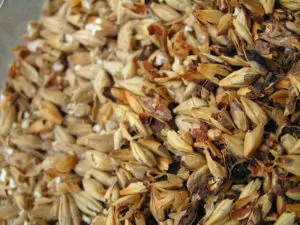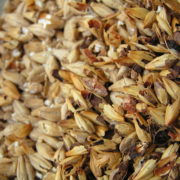Crystal Malt: What is it, Using it and Making It

In this article I want to give you a definitive guide to crystal malts, what varieties you can get,how they are made and why I love them.
So to begin with let’s take a look at what exactly crystal malts are and how they are made:
Ordinary malts like pale malt are made by taking your dried grains and germinating them like you would a seed. They are then kilned to stop the seed growing and that leaves you with malted grain that can be mashed to extract the stored sugars. Crystal or Caramel malts however are unique in the fact that the endosperms inside the grains are in effect mashed inside the hull. Undried malt is heated to mash temperature to convert starches to sugars before being raised to roasting temperatures. The grains are roasted to varying degrees depending on the intended variety and color of the finished crystal malt and then cooled. Once cool the sugars harden and give you that crystalline texture that’s associated with crystal malt.
As caramel malts are effectively already mashed grains they only require steeping to release the available sugars present in them, unlike other malted grains though, their method of production means that the kinds of sugars present are less fermentable. This provides a residual sweetness and body to the final brewed beer and also a caramel or toffee like character. As crystal malts don’t require any mashing and add body and character to the finished beer they are beneficial to extract brewers and all grain brewers alike.
Types of Crystal or Caramel Malt
Crystal malt: Depending on where you are or who you are the term Crystal and Caramel can be used interchangeably, they are the same thing. I have seen the term crystal used predominantly in the UK and caramel in the US. Typically crystal malt is sold by colour, either labelled with the lovibond rating or as either dark,light or medium. Character and flavours can vary greatly among the different colored crystal malts and even from different manufactures. I think most would agree though crystal malt lends a caramel, toffee and sometimes nutty character as well as sweetness. A medium crystal will lend a deep reddish or ruby color to beer if used in moderate quantities. As well as barley other grains such as wheat and rye are also crystallized in this fashion.
Cara Malts: These come in numerous varieties. This is either a trademark of the maltster or a general descriptive term. For example we have CaraVienne/CaraVienna and CaraMunich these are both German caramel malts that are kilned for varying lengths to achieve different colors. They are not mean’t to be used as substitutes for either Vienna or Munich malt in general but are in fact, Vienna or Munich malt that have been produced in the same way as other crystal malts. So the maltster has taken the Vienna or Munich malt and as described above crystalised it or mashed inside the hull.
There are numerous varieties of these Cara malts so below is a table stating the various attributes of each one as a reference.
| Name | Colour | Potential SG | Max. In Recipe |
|---|---|---|---|
| Cara-Pils/Dextrine | 2 SRM | 1.033 SG | 20.0 % |
| Caraamber | 30 SRM | 1.035 SG | 20.0 % |
| Carafoam | 2 SRM | 1.033 SG | 20.0 % |
| Caramel/Crystal Malt – 10L | 10 SRM | 1.035 SG | 20.0 % |
| Caramel/Crystal Malt – 20L | 20 SRM | 1.035 SG | 20.0 % |
| Caramel/Crystal Malt – 30L | 30 SRM | 1.035 SG | 20.0 % |
| Caramel/Crystal Malt – 40L | 40 SRM | 1.034 SG | 20.0 % |
| Caramel/Crystal Malt – 60L | 60 SRM | 1.034 SG | 20.0 % |
| Caramel/Crystal Malt – 80L | 80 SRM | 1.034 SG | 20.0 % |
| Caramel/Crystal Malt -120L | 120 SRM | 1.033 SG | 20.0 % |
| Caramunich Malt | 56 SRM | 1.033 SG | 10.0 % |
| Carared | 20 SRM | 1.035 SG | 20.0 % |
| Caravienne Malt | 22 SRM | 1.034 SG | 10.0 % |
Making Your Own Crystal Malt
Yes indeed. You can make your own crystal malt at home and I have done this a couple of times after reading Randy Moshers guide in Radical Brewing. As always experimentation is key and you can of course choose your base malt that you want to turn into a crystal malt. Bear in mind that you aren’t necessarily going to achieve the same results as a maltster.
Take a kilo of pale malt (substitute with pilsner, vienna or munich if you like) and soak it for 24 hours in either dechlorinated tap water or for ease, some bottled water. The grains will absorb a lot of the water and in effect be rehydrated. Drain the malt in a seive or colander to remove the excess water and then spread evenly in a baking tray so you have a layer no more than a couple of inches deep.
Place the malt on the tray in an oven at around 70°C or very close and bake for 2 hours. Make sure to keep a consistent temperature close to 70°C and the conversion of starch to sugars will take place inside the grain.
After the 2 hours conversion will be complete so its now time to completely dry the grains. Split the grain into 2 trays so you have a thinner layer and raise the temperature of the oven to 100°C or thereabouts. You will need to keep an eye on them now and turn frequently, otherwise as I have learnt you will end up with some dark dry grains and some pale ones. Turn every 20 or 30 minutes until it feels completely dry.
Once you reach this point you can stop there and your Crystal will be ready to brew with or you can kiln it further to add colour and more flavour. To do this raise the temperature to 150°C and turn more frequently to ensure even browning. It’s a good idea to be cautious with this as to not overdo anything and end up with crystal malt that’s to dark and roasty. You can kiln at lower temperatures for longer to achieve mellow character or high and faster for more roasty and bitter character. Experimentation is key.
Making your own crystal malt is a fun process and you learn a lot about malting in general, it does take time though and patience, be prepared to do a bit of trial and error before achieving just what you want.



I’m intrigued by crystal malt now, much more than before when I thought it was “just another grain.” However, I do not see the chart of attributes. Can you post a link to that?